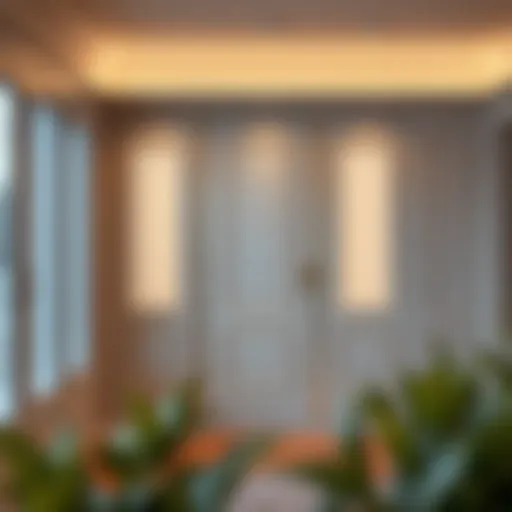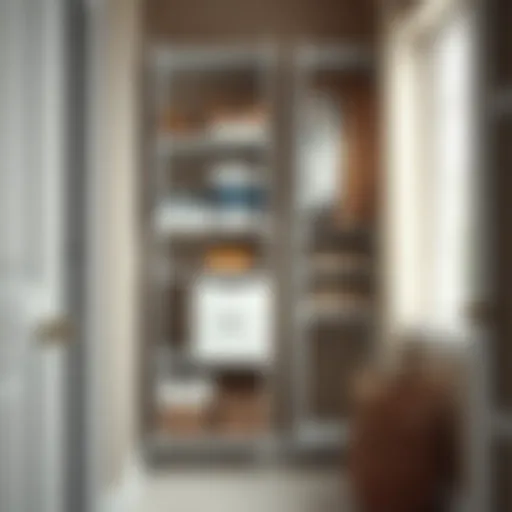Hallway Closet Designs: Maximize Functionality and Style

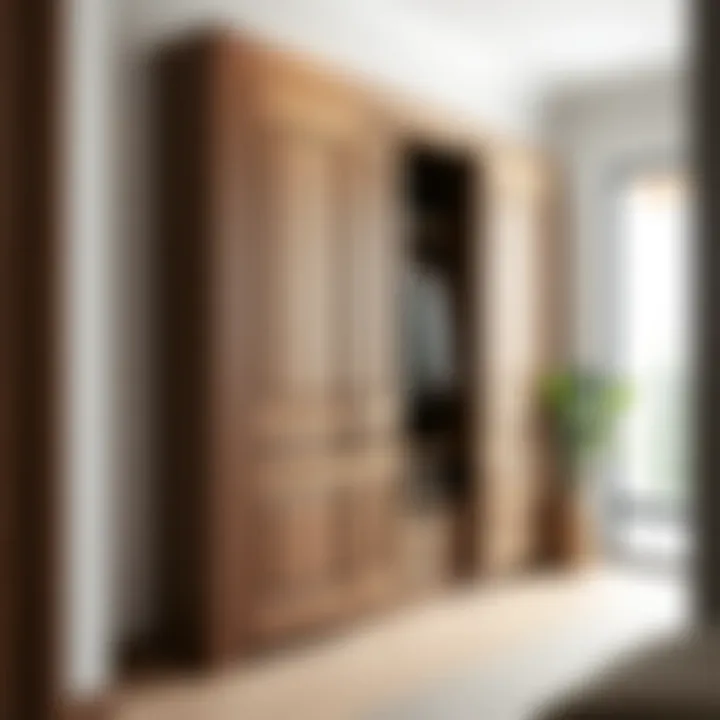
Intro
When it comes to hallway closets, they often act as the unsung heroes of our homes, providing storage without the spotlight. The design of these small spaces can significantly impact the overall functionality of your home. A well-thought-out hallway closet can save you from the clutter blues, allowing for everything from shoes to seasonal jackets to find a designated spot. As homeowners and design enthusiasts seek to maximize their living environments, understanding the ins and outs of closet design is crucial.
This article is geared towards illuminating the best practices and innovative designs that can elevate your hallway closet from mundane to magnificent. Whether you’re a DIY enthusiast looking to spruce things up or a real estate agent who needs to showcase a property’s potential, the insights presented here will guide you through making choices that marry practicality with aesthetics.
Next, we will dive into the evolving landscape of closet design, exploring the trends that are shaping how we think about storage — because it’s not just what you store, but how you store it that counts.
Overview of Hallway Closet Designs
The design of a hallway closet is a quintessential element in maximizing the functionality and aesthetic of a home. Unlike other storage areas, hallway closets often serve as a transitional space between rooms, making their design all the more important. They are typically the first point of contact for guests and often hold a variety of items - from coats and shoes to cleaning supplies and seasonal decorations.
Creating an efficient closet helps ease clutter, improving not just the organization of a space but also enhancing the overall flow of your home. A well-planned hallway closet can significantly impact daily routines, saving time and effort in locating everyday essentials. In short, it's not simply a matter of storing belongings; it’s about optimizing your living environment for convenience and style.
Historical Context
Hallway closets have evolved significantly over time. Early American homes often featured straightforward coat racks or hooks. As homes expanded and the concept of storage matured, closets began incorporating doors for privacy and dust protection. This evolution reflects broader changes in social behaviors, such as the increasing need for organization and the emphasis on appearances. By the 20th century, built-in closets became a standard feature in residential design, indicating the value placed on storage efficiency and home aesthetics.
Modern Relevance
In today's fast-paced world, the relevance of hallway closet designs cannot be overstated. With the rise of urban living, many homeowners find themselves challenged by limited square footage. As a result, every inch of space must be utilized wisely. Hallway closets have transformed into multifunctional areas that can accommodate various needs. The integration of innovative storage solutions, such as adjustable shelving and smart organizational tools, make these spaces versatile. Moreover, as sustainability rises on the list of priorities for homeowners, eco-friendly materials in closet design are increasingly popular. This modern relevance underscores the necessity of effective closet designs that reflect changing lifestyles and values.
A well-designed hallway closet is more than just a storage space; it’s an integral part of a home’s efficiency and visual appeal.
Assessing Your Hallway Space
When it comes to maximizing every inch of your home, assessing your hallway space is a game changer. This step is crucial in the process of designing a hallway closet. Without a thorough understanding of your available space, the rest of your design might just be smoke and mirrors. Measurement and flow are the two main considerations that form the groundwork for a solid closet plan.
Measuring Dimensions
Before diving headfirst into designs or aesthetics, it’s essential to take a step back and measure the dimensions of your hallway accurately. This not only includes the width and length but also the height. A tight squeeze can turn into a nightmare if you’ve designed a closet that simply doesn’t fit.
- Height Matters: Measure from the floor to the ceiling. Don’t forget to account for any ceiling fixtures. Doing so can also inspire options for vertical storage solutions.
- Width and Depth: Here, you’ll want to see how wide your closet can be while still allowing room for everyday movement. If it feels cramped every time someone walks past, that space can lose its functionality; a closet may boost your organization, but an obstruction is just an annoyance.
- Mark it Out: Use painter’s tape to outline the dimensions of your prospective closet on the floor. This will help visually orient yourself to the potential fit. Also, consider the swing of the door if you opt for one — it shouldn’t interfere with the traffic flow in the hallway.
- Existing Features: Don’t overlook existing elements like electrical outlets or wall moldings, as they may dictate what you can do with your closet’s layout.
Identifying Traffic Flow
Once you’ve got your dimensions sorted, the next focal point is identifying traffic flow through your hallway. Understanding how people navigate the space is vital for functional design.
- Observe: Stand back and take a mental note of how the space is used day-to-day. Is it a main thoroughfare to other rooms or just a quiet corridor? This will aid you in determining the right kind of cabinetry and shelving.
- Natural Movement Patterns: For instance, if family members frequently dash in and out, you might want to avoid styles that protrude too far into the hall. Areas that receive heavy traffic would benefit from design solutions that remain flush with the wall.
- Flexibility: Consider incorporating adjustable shelving or open cubbies for frequently used items, making them easy to grab.
- Creating Zones: If your hallway leads to various rooms, it may be beneficial to segment storage solutions. This way, you can designate specific areas for seasonal items, outdoor gear, or cleaning supplies without congesting the walkway.
The more you understand your space and its flow, the better you can design a hallway closet that enhances, not hinders, your home's usability.
With a clear grasp on dimensions and traffic patterns, you can start to develop a more detailed design plan tailored to your hallway's unique characteristics. This groundwork allows for creative freedom within practical boundaries, ensuring that your hallway closet not only looks great but functions well too.
Design Considerations
When it comes to designing a hallway closet, the considerations that inform the final layout and appearance are paramount. This section focuses on how design elements can serve both function and aesthetic appeal, ensuring that the closet is not only practical but also enhances the surrounding space. Making thoughtful choices regarding functionality and appearance can lead to improved organization and home enjoyment.
Functional Needs
Seasonal Storage
Seasonal storage is a critical aspect of closet design that addresses the fluctuating demands for space throughout the year. As seasons change, so do the items we use, from coats and hats in winter to beach towels and swimsuits in summer. A well-planned seasonal storage solution maximizes efficiency by incorporating features that can easily be adjusted or reconfigured as needed. This flexibility is key; it allows homeowners to switch out items seamlessly.
The defining characteristic of seasonal storage is its ability to adapt, rather than demand constant structural changes. It's a beneficial choice for this article's focus on functionality. Seasonal storage can consist of sliding baskets, overhead shelving, or designated bins, providing a unique feature that can be tailored to individual preferences. The advantage of such systems lies in their ability to clear clutter while also keeping items accessible throughout different times of the year. However, neglecting to regularly swap out items can lead to overcrowded spaces that defeat the purpose of design efficiency.
Outdoor Gear Organization
Outdoor gear organization represents another vital functional aspect of hallway design. From bicycles to hiking boots, the variety of items associated with outdoor activities can create chaos if not properly arranged. A specialized approach is essential to manage this variety of gear effectively. This segment of a closet might employ rugged surfaces, durable shelving, and hooks specifically designed for outdoor items, making it easy for users to locate and return gear after use.
The main characteristic of outdoor gear organization is durability and accessibility. Fixtures and forms tailored to accommodate bulky or frequently used items can prevent clutter and encourage a sustainable outdoor lifestyle. This approach is popular among homeowners who enjoy outdoor activities, as it streamlines the process of preparing for adventures. The downside could be the need for careful consideration of space allocation, as improperly managed gear can still turn a well-designed area into a disorganized mess.
Aesthetic Choices
Style Consistency
Style consistency in hallway closet design ensures that the appearance of the closet aligns with the overall home décor. Keeping a cohesive design creates a sense of tranquility and order, impacting the way space is perceived. This consideration cannot be overlooked, as a disjointed style can transform a potentially inviting space into one that feels jarring.
The fundamental characteristic of style consistency is the repeating elements throughout the closet. This could be in the form of similar wood finishes, matching metal hardware, or uniform colors that mirror adjacent rooms. Such consistency is a popular choice for design-savvy homeowners wanting to impress their guests with an unblemished look. The challenge with this approach is maintaining creativity while adhering to a theme; too rigidly following a style guide might stifle unique personal touches.
Color Palette
The color palette chosen for a hallway closet can greatly affect both its visual appeal and the ambiance of the surrounding space. Using a well-thought-out scheme—whether it's calming neutrals or vibrant accents—contributes not only to the aesthetic but establishes a mood. An engaging color palette invites homeowners and guests alike to appreciate the functionality of the space, transforming it from a mere storage area into a visually appealing part of the home.
The characteristic of a color palette is its emotional and psychological impact; certain colors can evoke different feelings or states of mind. Embracing a mix of bold and soft tones is a beneficial choice, as it allows for flexibility and personalization based on one’s own style and comfort. On the flip side, choosing incompatible colors might create a discordant atmosphere, undermining the overall design goals of cohesion and beauty.
Material Selection
Choosing the right materials for hallway closets is a fundamental aspect of functional design. The materials you select not only determine the longevity of your closet but also play a significant role in its visual appeal and functionality. A thoughtful approach to material selection can enhance the overall design, ensuring that the closet meets both practical needs and aesthetic preferences.
Wood Options
Solid Wood vs. Plywood
When it comes to wood options, one often ponders the merits of solid wood versus plywood. Solid wood boasts a natural aesthetic and durability that often stands the test of time. It brings a warmth and earthiness to hallway spaces, making it a popular choice among homeowners who prefer an inviting atmosphere. On the other hand, plywood is known for its versatility and cost-effectiveness, presenting a more affordable yet sturdy alternative.
A significant characteristic of solid wood is its ability to withstand wear. With the right care, solid wood can last for generations. However, it can be prone to warping in humid environments. Conversely, plywood, while not as visually appealing as solid wood, offers superior resistance to moisture, making it an excellent choice for areas that may face humidity fluctuations.
In summary, solid wood provides aesthetic benefits and long-term durability, while plywood excels in practicality and moisture resistance. Your decision likely hinges on the balance between desired aesthetics and the intended use of the closet.
Finishing Choices
Finishing choices are essential in elevating the appearance of your hallway closet. Different finishes can dramatically alter the look and feel of wood materials. Common finishing options range from matte to glossy finishes. Each has its benefits; for instance, matte finishes tend to conceal scratches well, while glossy finishes can enhance color vibrancy and are easier to wipe down.
A unique feature of modern finishing techniques is their ability to incorporate stains that can express a rich hue while protecting the base material. This not only ensures that the closet maintains its allure but also prolongs its lifespan. However, a downside to certain high-gloss finishes can be their susceptibility to fingerprints and smudges, which might require more frequent cleaning.
Ultimately, the right finish will depend on your style preferences and the amount of maintenance you’re willing to undertake for upkeep.
Metal and Other Materials
Durability Considerations
In the realm of metal and other materials, durability takes center stage. Metals like steel or aluminum are often lauded for their incredible strength and resilience. Choosing metal options means opting for materials that can handle wear and tear effectively, making it a smart move for busy households.
The standout aspect of metal is its natural resistance to insects and decay, which can be common issues with wooden materials. Metal storage options can provide a sleek, contemporary look that complements a modern hallway. However, it’s essential to consider potential drawbacks, such as the cold feel of metal that may not resonate with a homey ambiance.
Overall, when looking for materials that promise durability, metal ranks high on the list, offering an enduring solution for your storage needs.

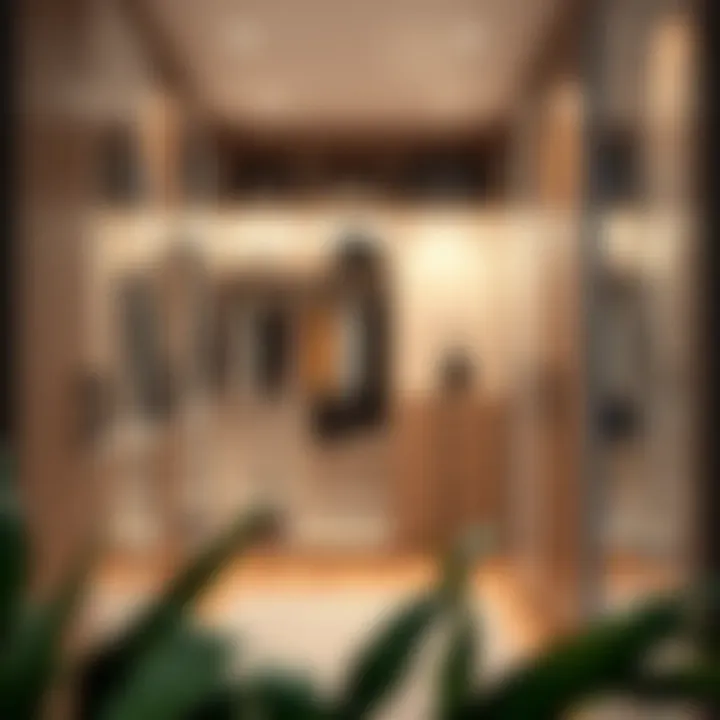
Textured Finishes
Textured finishes can add depth and character to hallway closets while also serving practical purposes. These finishes come in various forms, from brushed to hammered textures. They offer a unique visual appeal that can break the monotony of smooth surfaces.
A distinctive characteristic of textured finishes is their ability to hide minor scratches and wear. This feature can significantly reduce the visual impact of damage over time. However, one should consider that cleaning textured surfaces may require more effort compared to smooth ones, as dirt can accumulate in the crevices.
"Selecting materials wisely is half the battle won in closet design. Style and substance must go hand in hand to ensure you create a functional piece that enhances your home."
Innovative Storage Solutions
Innovative storage solutions play a pivotal role in hallway closet design, addressing the modern needs of homeowners who want to maximize space without compromising functionality. The idea is to create clever systems that not only organize but also streamline everyday access to items. In a time where maximizing every square inch in our homes is often a quest, creative storage solutions become essential.
Balancing functionality with aesthetics is a common challenge, but innovative storage solutions like custom shelving and hidden storage techniques accomplish just that. The benefits here extend beyond mere organization; they provide opportunities to showcase personal style and ensure that every item has its designated place.
Custom Shelving
Adjustable Shelves
Adjustable shelves are one standout feature that contributes significantly to effective storage solutions in hallway closets. The key characteristic of adjustable shelves is their flexibility, allowing homeowners to modify the shelf height as their storage needs evolve. This makes them particularly beneficial for accommodating a variety of items, be it stackable bins or towering boots.
One unique feature of adjustable shelves is that they often come with built-in notch systems. This allows for easy modification without the need for new hardware or tools. The major advantage lies in their capacity to adapt to seasonal changes; during winter, they can hold bulky jackets while in summer, they might just house light summer dresses.
However, the downside might be the initial installation which could be a bit tedious if not done with care. If not secured properly, they may sag under heavy loads. But with a bit of attention, the benefits often outweigh these minor drawbacks.
Built-In Units
Built-in units are another remarkable consideration for hallway closet designs. What sets built-in units apart is their seamless integration into the existing architecture of the home, providing a neat and polished look. These units are often seen as a popular choice because they not only maximize storage but also enhance the overall design of the space.
A distinctive aspect of built-in units is their tailored design. They can be customized to fit awkward spaces that standalone furniture simply cannot address. This advantage greatly helps in maintaining a coherent flow in your home’s decor.
On the flip side, built-ins can necessitate a higher initial investment compared to off-the-shelf solutions, but many find their long-term functionality and aesthetic payoff is well worth it.
Hidden Storage Techniques
Hollow Doors
Hollow doors are an often-overlooked feature that brings functionality to hallway closets. They serve as more than just entrances; their unique characteristic is their ability to hide a wealth of storage. You can utilize the space between the door panels to store small items like shoes, cleaning supplies, or even tools that typically clutter up your home.
The benefit of using hollow doors lies in maximizing your storage capacity in a way that's completely unobtrusive. They're especially advantageous in tight spaces where adding even a small shelf could feel overwhelming. However, one should consider that using them demands a careful selection of items since they require space to ensure the door opens freely without obstruction.
Under-Bench Compartments
Finally, under-bench compartments provide yet another ingenious way to enhance storage. Often found in mudrooms or entryway benches, these compartments are discrete yet efficient. The key characteristic of under-bench compartments is that they utilize space that would otherwise go to waste, allowing you to store seasonal items, shoes, or even pet supplies under a functional seating area.
This configuration not only keeps the area tidy but also enhances usability. Still, one consideration might be the depth of these compartments. While deep storage is useful, it can sometimes make it difficult to reach items stored far back, which can be a slight inconvenience.
In summary, innovative storage solutions such as custom shelving and hidden techniques can transform your hallway closet into a functional, stylish space. Embracing these approaches can lead to a well-organized home that truly meets your needs.
Lighting Enhancements
When it comes to hallway closets, lighting can make all the difference. It's often overlooked but plays a vital role in both functionality and overall aesthetics. In tight spaces, proper lighting can transform a dim, cramped area into an inviting nook that’s both usable and stylish. Whether directing movement, enhancing visibility, or simply contributing to decor, lighting choices are crucial.
Natural Light Considerations
Natural light is a breath of fresh air, illuminating the smallest of spaces, making them feel larger. If your hallway closet has any access to windows or open areas, leveraging this natural light can elevate the overall feel of the space. Light-colored walls can reflect this sunlight, enhancing brightness and warmth. When designing your closet, consider using glass doors or transparent shelving that allows light to filter through. Such choices can create an airy ambiance while helping you locate items easily.
To achieve the best natural light input:
- Keep window treatments minimal to avoid blocking sunlight.
- Use mirrors to further reflect light within the space.
- Choose lighter finishes for shelves and walls to amplify the daylight coming in.
Installed Lighting Fixtures
When natural light isn't sufficient, installed lighting becomes your best friend. Good fixtures not only brighten the closet but also add a layer of design and style. Options vary significantly, from overhead lights to motion-sensor lamps, tailored to fit any needs a homeowner might have.
LED Options
One of the most favorable choices is LED lighting. This kind of light source is extremely energy-efficient compared to traditional bulbs. LEDs can last up to twenty-five times longer, which means less hassle for homeowners. They emit less heat, decreasing the risk of overheating in tight spaces, an important consideration in a closet.
Moreover, the variety of LED fixtures available today means that you can pick ones that suit your decor style, whether sleek and modern or rustic country. A standout feature of LEDs is their dimmable nature, which allows users to adjust brightness depending on the time of day or activity. However, on the downside, the initial investment can be more than conventional lighting, though the savings on energy bills typically make up for this.
Accent Lighting
Accent lighting adds another layer of depth to your hallway closet. These fixtures focus light on particular items or areas, such as artwork or decorative pieces, adding an interesting visual element. The vibrant illumination can highlight any personalized touches, such as family heirlooms or decorative storage boxes.
What makes accent lighting attractive is its versatility. You can achieve it through recessed lighting, pendant fixtures, or even wall-mounted sconces. However, it’s essential to plan its placement carefully. If the light source is too close, it can create harsh shadows. Similarly, if placed too far, it may not provide adequate illumination.
- Key Features of Accent Lighting:
- Focused illumination to enhance decor
- Available in various styles for personalized decor
Accessibility Features
In today's world, making home spaces accessible for everyone isn't just a nice-to-have, it's a necessity. Hallway closets, often overlooked, can pose considerable barriers if not designed with accessibility in mind. Addressing this topic means acknowledging the diverse needs of users, especially individuals with mobility issues. By incorporating accessibility features, homeowners can create spaces that are not only functional but also welcoming for all members of the household and their guests.
Wheelchair Access
One of the primary concerns in hallway closet design is ensuring that there is adequate space for wheelchair access. This involves more than just the width of the opening. Consider the turning radius and whether the closet layout permits easy maneuverability. A minimum width of 32 inches is generally recommended for doorways to allow for wheelchair users.
Additionally, a well-planned space should have a flat surface—no thresholds or stairs—leading to the closet. This provides a seamless transition, enabling greater independence. Moreover, keeping the space uncluttered is vital. A clear path to the closet ensures that those using wheelchairs can access the storage without obstacles.
Adjusting Heights
As one contemplates designing an accessible hallway closet, height adjustments come to the fore. This aspect ensures that users don’t need to strain or reach excessively, thus promoting safety and convenience.
Lowered Shelving
Lowered shelving can be a game-changer in accessibility. This design element allows for easy access to items without the need for ladders or reaching precariously. A shelf height of around 48 inches, rather than the standard 60 inches, can make a world of difference.
This ensures that frequently used items, such as jackets or bags, are within arm's reach. It's particularly beneficial in households with children or senior citizens, as it reduces the risk of falls and injuries. However, one should consider the balance of aesthetics and functionality. Lowered shelves can sometimes crowd the visual space if not planned thoughtfully. Striking that balance is key to a visually appealing and practical design.
Pull-Out Drawers
Pull-out drawers are another valuable addition to any accessible hallway closet design. They provide a simple way to retrieve items stored deeper in the closet without the need to squat or bend down. This feature can be especially helpful for individuals with limited mobility or back issues.
With smooth gliding mechanisms, these drawers enable effortless access to stored goods while keeping everything neatly organized. Additionally, they come in various sizes and configurations, allowing homeowners to tailor their use according to specific needs. The only downside might be their installation cost, which can be higher than fixed shelves. Nevertheless, the user-friendly aspect often outweighs the initial expenditure.
In summary, these key components—wheelchair access, lowered shelving, and pull-out drawers—are critical for ensuring that hallway closet designs cater to a wide range of mobility levels. By considering such features, homeowners can create spaces that not only improve functionality but also enhance the overall quality of life for everyone.
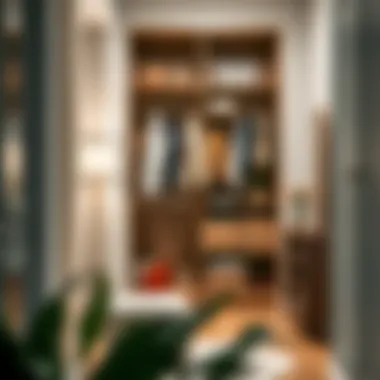
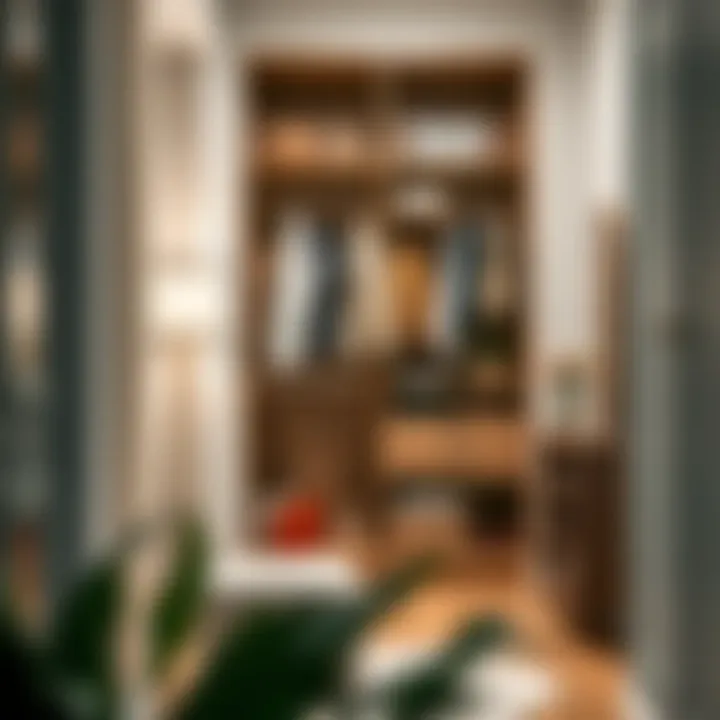
Color and Finish Trends
Color and finish trends play a pivotal role in the design of hallway closets, influencing both their functionality and aesthetic appeal. The right choices can create a seamless blend between style and usability, ensuring that this space is not just a storage area but also an extension of your home's decor. As they say, 'you never get a second chance to make a first impression'; when entering a home, the hallway closet is often the first space seen, making its appearance essential.
Popular Color Schemes
Neutral Tones
Neutral tones, such as soft grays, warm beiges, and crisp whites, are a go-to choice in modern design for good reason. They provide a calming effect, allowing the surrounding decor and furnishings to shine without clashing. In the context of hallway closets, these shades create a sense of spaciousness and cleanliness.
One of the unique features of neutral tones is their versatility. They can easily complement bold accessories or contrasting colors introduced through decorative accents. For instance, a beige closet can beautifully serve as the backdrop for vibrant shoes or hats, ensuring that the closet appears organized yet lively.
However, it’s worth noting that while neutral tones are timeless, they can sometimes fall prey to being a little bland if not paired with interesting textures or pops of color. Striking a balance is crucial; introducing key decorative elements can elevate the entire space. A neutral hall closet dressed with various textures can feel quite chic.
Bold Accents
In stark contrast, bold accents can create a statement that draws attention and ignites conversation. Molten oranges, deep blues, or rich burgundies can act as focal points in what is typically a subdued space. Utilizing hues like these in a hallway closet can transform its utility into a visual spectacle, taking it from forgettable to fabulous.
Key characteristics of bold accents include their ability to energize a space. A bright red shelving unit, for example, can invigorate an otherwise dull corridor and be significant in infusing personality into the design. This not only enhances the closet but can also influence the perception of the whole hallway.
While bold accents are fantastic for adding flair, they do require careful thought. Too many vivid colors can overwhelm a space, potentially leading to visual chaos. Selecting one or two bold elements ensures that the design remains striking yet harmonious.
Finish Variations
Matte vs. Gloss
The choice between matte and gloss finishes can significantly impact the overall vibe of your hallway closet. Matte finishes provide a soft and sophisticated look, giving surfaces a more understated elegance that can feel both modern and cozy. They tend to hide imperfections better, making them a practical choice for high-traffic areas.
On the other hand, gloss finishes offer a more reflective surface that can enhance light and brighten a space. They convey a sleek and polished appearance, which can be particularly appealing in smaller areas where maximizing light is critical. However, gloss surfaces may reveal fingerprints and smudges more readily, requiring more maintenance.
A nuanced consideration here is to find the balance; using a matte finish for walls with high gloss accents on shelves might just create that perfect contrast.
Satin Finishes
Satin finishes serve as a happy medium between matte and gloss. They possess a soft sheen, making them visually captivating without the starkness of high gloss. Satin finishes are often more desirable due to their durability and ease of cleaning. This quality makes them particularly fitting for areas that experience frequent use, such as hallway closets.
Additionally, satin finishes tend to reflect light softly without overwhelming glare, which helps in maintaining a relaxed ambiance. However, one must be cautious about the paint or material quality, as some lower-grade satin finishes may not hold up well over time, leading to premature wear. Investing in a high-quality product becomes essential if durability is a priority.
In summary, selecting the right colors and finishes for your hallway closet is more than just about simple aesthetics. It’s an intricate dance of functionality, impression management, and personal expression. From neutral tones that embody sophistication to the excitement of bold accents, every choice speaks to you as a homeowner. Consideration of finishes adds yet another layer of intricacy that, when applied thoughtfully, can transform your hallway closet from an afterthought into a striking feature of your home.
Personalization Options
Personalization transforms a hallway closet from a mere storage area into a reflection of one's individual style and practical needs. This section emphasizes how custom features can make even the most utilitarian spaces more enjoyable and uniquely suited to a homeowner's lifestyle. With the right approach to personalization, a hallway closet can blend seamlessly with the overall home decor while providing functionality that suits everyday life.
Decorative Accents
Artwork Displays
When it comes to making your hallway closet stand out, incorporating artwork displays can breathe life into otherwise mundane storage spaces. Having a piece of art or unique photography visible can create a connection with the space, giving it character. This choice speaks to the heart of the design, adding a personal touch that resonates with family and friends.
“Artwork offers a glimpse into the soul of the home, often sparking conversations and memories.”
A standout characteristic of artwork displays is their versatility. They can be mixed and matched with various styles, from contemporary to rustic, ensuring there's something for everyone. However, it's important to consider how well the color palette of the artwork complements the rest of the hallway. The uniqueness can also influence aesthetics tremendously, although you should keep in mind that installation must respect the functional aspects of the closet itself, ensuring nothing obstructs storage capabilities.
Seasonal Decor
Seasonal decor brings a lively energy to a hallway closet, allowing homeowners to keep things fresh throughout the year. By switching out items like decorative boxes, fabric colors, or even arrangement configurations, homeowners can celebrate seasons or holidays. This flexibility enhances the space's emotional appeal and makes it dynamic.
Key to seasonal decor is its adaptability, making it easy to swap items with changing trends or personal feelings. However, balancing aesthetics with practicality is essential. It’s vital to not overcrowd the closet space with too many decorations, as its primary purpose is organization. Done well, seasonal decor can uplift the overall feel of the hallway while still serving as a convenient storage solution.
Functional Customization
Labeling Systems
Implementing a labeling system in your hallway closet adds layers of organization that can simplify everyday life. Labels make it easy to quickly find items, streamlining daily routines. This aspect is especially useful for busy families or individuals who often find themselves scrambling to locate necessary items.
A prominent characteristic is that labeling can be as simple or as elaborate as desired. From straightforward sticker labels to personalized wooden tags, the choices are plenty, while the advantage lies in increased efficiency. However, it’s important to maintain consistency in labeling styles, so the system remains user-friendly for everyone in the household.
Modular Units
Opting for modular units in your hallway closet allows for flexibility and adaptability. These systems can be reconfigured to fit changing storage needs or shifts in personal style preferences. Their modular nature means that as your belongings grow or change, your storage can easily keep up.
A major advantage of modular units is the ease with which you can add or remove components based on current requirements. However, consider that not all modular setups will fit every size or shape of a closet, so it’s necessary to measure your space carefully. Overall, modular units provide an ideal balance between functionality and versatility, ensuring that the closet evolves as the homeowner’s needs do.
Maintenance and Care
Maintaining a hallway closet may not seem like a high-priority task, but it plays a critical role in ensuring that these spaces remain both functional and visually appealing. Proper maintenance can enhance the longevity of your closet's design and keep it organized, making it easier to retrieve the items you need when you need them. An well-maintained closet also contributes to the overall aesthetic of your home, creating an inviting atmosphere as friends and family pass through.
Regular Cleaning Practices
Cleaning your hallway closet should not feel like pulling teeth. It’s easier than one might think. Creating a routine cleaning schedule helps in preventing clutter from accumulating over time. Here are some tips for effective cleaning:
- Schedule Promptly: Take a moment to clear out items that are no longer needed immediately. Make this a habit every couple of months to keep things in check.
- Use the Right Tools: A vacuum cleaner or a microfiber cloth can be perfect for sweeping away dust. Also, consider using a soft-bristled brush for those hard-to-reach corners.
- Organize Before You Clean: Before you even start cleaning, it helps to empty out the closet briefly, examine each item, and find a space for things rather than merely tossing them back into the closet.
Apply a multi-surface cleaner to prevent the build-up of dust and dirt on shelves and on the floor, and be sure to wipe down any surfaces that may not get touched often.
Long-Term Care Tips
Preventing Damage
Preventing damage is key to ensuring your hallway closet remains inviting and functional over time. The primary characteristic of this approach is vigilance. Noticing minor issues before they escalate can save you time and money in the long run. One effective practice is to keep an eye out for signs of wear, issue like:
- Water Stains: Look for any signs of dampness or leaks from surrounding plumbing. Drying these spots quickly can prevent mold growth.
- Wear and Tear on Hinges: If you notice creaking or resistance when opening doors, lubricating the hinges can be a quick fix to prevent further degradation.
Addressing these concerns promptly maintains your closet's integrity, ensuring it remains a functional space.
Material-Specific Guidelines
When assessing maintenance strategies, understanding the materials used in your closet is vital. For instance, solid wood will have different care needs compared to laminate surfaces.
- Wood finishes: While solid wood is beautiful, it may require occasional polishing with a wood conditioner to avoid drying out and cracking. This method not only extends the life of the wood but also adds a rich, warm look.
- Laminate and Metal: These materials usually require simpler care – often just a wipe with a damp cloth and a non-abrasive cleaner can do the trick. However, be careful with metal surfaces that may be prone to corrosion if exposed to moisture.
In summary, understanding how best to maintain your hallway closet greatly influences its longevity and functionality. By consistently implementing regular cleaning practices and understanding your specific materials, homeowners can preserve their closet designs effectively. With this knowledge in hand, you will find that maintaining your closet is less of a chore and more of a rewarding practice.
Case Studies and Inspirations
In the realm of hallway closet designs, exploring case studies and inspirations not only enlightens homeowners and designers about existing solutions but also sparks fresh ideas that resonate with their own spaces. Taking cues from real-life examples illustrates how variations in design translate into enhanced functional and aesthetic results, capable of aligning with personal requirements and taste. Whether you live in a compact apartment or in a sprawling residence, looking at successful implementations can guide you toward making educated design choices.
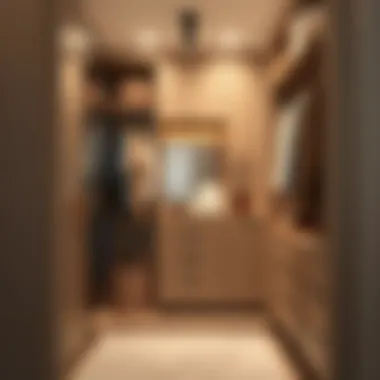
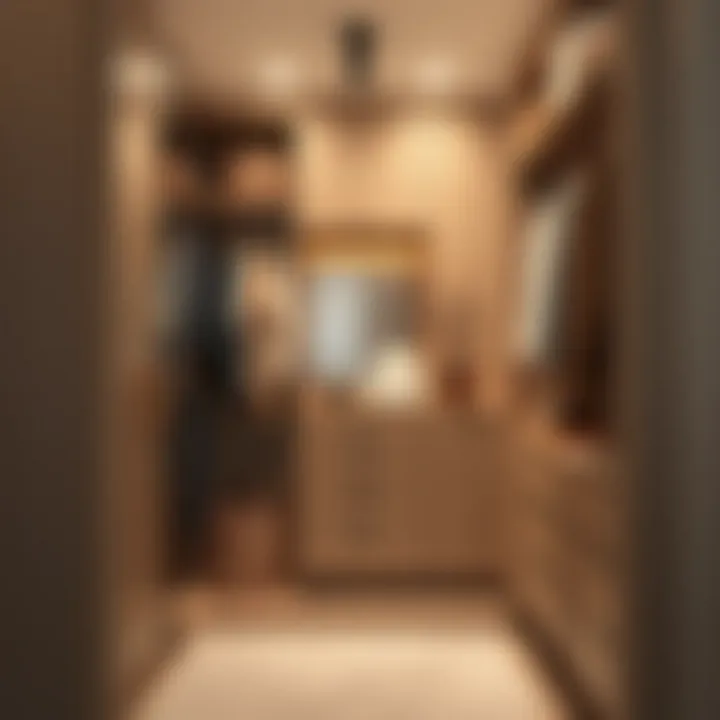
Small Space Solutions
When dealing with limited hallway space, maximizing storage is key. One prominent solution is the use of vertical storage options. For instance, installing tall cabinets that reach the ceiling can offer ample storage without encroaching on the floor space. It’s not just about adding storage; it’s about utilizing every inch effectively. Many homeowners have reported significant improvements in accessibility and organization when employing shelving units that are both functional and attractive.
Example: Consider a case where a small hallway closet was transformed by incorporating floating shelves. These shelves not only drew the eye upward, creating an illusion of height, but they also served as excellent spots for decorative boxes or books, marrying style and practicality.
Another technique is the integration of pull-out racks or bins. These features allow easy access without having to dig through a pile of items. They cleverly turn a tight closet into a functional space that pulls its weight. In one case study, a homeowner utilized pull-out bins for shoes, significantly reducing clutter and ensuring that each pair was visible and easy to retrieve.
Also, mirrored doors can help make a small space feel larger and brighten it up by reflecting light. It's a stylish way to keep your entries looking spacious and appealing, proving that aesthetic choices deeply affect perception of space.
Luxury Designs
On the opposite end of the spectrum, luxury hallway closets can offer an unparalleled combination of opulence and function. Such designs typically feature high-end materials and sophisticated finishes. Wood species like walnut or cherry, alongside custom metal hardware, lend an air of elegance. A well-executed luxury design can often feel like a boutique experience right at home.
Imagine an example where a hallway closet integrates leather-wrapped drawer fronts, subtle lighting within glass-front cabinets, and polished stone countertops. The blend of these materials adds depth and character to the space, engaging the senses right upon entry.
Additionally, luxury doesn't just rest in looks; it can also come with smart technology. In one high-end project, a closet was equipped with automated lighting that sensed when the door opened, illuminating the space to welcome the user. This not only enhances usability but showcases modernity in design.
"A luxury closet should feel like a personal retreat, an area where every piece of clothing is displayed beautifully and organized meticulously."
Overall, while luxurious designs can serve as aspirational goals, they can also inspire manageable upgrades. Elements like high-quality finishes or custom cabinet layouts offer a pathway towards elevating standard every-day storage into something truly refined.
Sustainability in Closet Design
The discussion around sustainability in closet design goes beyond merely eco-friendly choices; it encompasses a holistic view on how our decisions impact the environment. Homeowners today are increasingly conscious of how materials and products used in their homes contribute to ecological well-being. Being sustainable means embracing practices that not only beautify our hallways but also promote longevity and reduce waste.
Using sustainable materials in your hallway closet can have a profound impact on both your carbon footprint and your overall design aesthetic. Besides this, these materials often come with the bonus of being durable. Therefore, the choice you make shapes your home's ambiance as well as respects the planet.
Eco-Friendly Materials
Choosing eco-friendly materials is paramount for achieving a sustainable design. This involves selecting options that are both environmentally friendly and functional, allowing for an outstanding balance between style and utility.
Bamboo Options
Bamboo has become a celebrated choice for those aiming to design an eco-friendly space. What sets bamboo apart from traditional wood is its rapid growth; this grass reaches maturity in just a few years, making it a highly renewable resource. Unlike hardwoods—which take decades to mature—bamboo packs a powerful punch in terms of sustainability.
A key characteristic of bamboo is its strength and durability. When used in closet designs, bamboo not only holds up well against daily wear but is also moisture-resistant, helping to prolong the lifespan of your storage solutions. Additionally, its natural beauty lends itself well to a variety of design styles, whether you lean toward minimalist frameworks or prefer something a bit more intricate.
However, it's important to note the nuances regarding bamboo products. An occasional downside includes the finish applied to bamboo products; some finishes may contain chemicals that offset their eco-friendly appeal. Thus, opting for natural finishes or asking questions about your material's treatment during sourcing is crucial.
Recycled Metals
In recent years, recycled metals have become a sought-after material in sustainable hallway closet designs. Notable for their durability and resistance to wear, recycled metals come from various sources, such as dismantled structures or leftover scrap. Using recycled metals significantly reduces the demand for new materials, thereby decreasing energy expenditure associated with production.
A distinguishing feature of recycled metals is their versatility. These metals can be transformed into sleek shelves or decorative hooks, providing a modern touch while helping maintain a lower environmental impact. Metal, in general, has a long lifecycle, and when it comes to closet design, this means your investment stands the test of time.
Nevertheless, embracing recycled metals has its challenges. Sourcing high-quality metals requires diligent research. Not every product marketed as “recycled” meets the standards that you, as a conscious consumer, would expect. If durability and style align with your goals, be sure to inquire about the source and processing to ensure authenticity.
Energy-Efficient Lighting
Lighting plays a crucial role, not just in aesthetics but also in sustainability. Energy-efficient lighting, such as LED options, should be your go-to choice when designing a closet space. LEDs consume far less power than traditional bulbs and last significantly longer, reducing both electricity usage and waste. Additionally, incorporating natural light sources, such as strategically placed mirrors, could enhance the overall aesthetic without having to rely heavily on artificial lighting.
A sustainable hallway closet is an investment in both aesthetics and the environment—all while exploring unique material options that excite and inspire.
Technological Advances
In the modern age, technology has seeped into every nook and cranny of our homes. When it comes to hallway closets, this shift brings significant improvements in organization and functionality. Today's technological advances transform what was once a simple storage space into an efficient system tailored for your needs. From managing clutter to enhancing accessibility, these innovations are more than just tech for tech's sake; they are tools that make our lives simpler and our homes smarter.
Smart Storage Solutions
Automated Systems
Automated systems are the future of smart storage solutions. These systems use mechanical and digital components to simplify the organization process. Imagine a closet where shelves can rise and lower at the touch of a button, or sections that can be revealed or concealed with the slide of a panel. The standout characteristic of automated systems is their ability to adapt to your immediate storage needs, making them a valuable addition to hallway closets.
The most appealing feature of these systems lies in their convenience and time-saving aspects. You can store your seasonal gear during off-seasons and quickly access what you need when the time comes. However, one should also consider the costs involved in installation and maintenance. Automated systems can be on the pricier side, but for those who value efficiency, the investment can yield remarkable benefits.
App-Controlled Storage
App-controlled storage takes the idea of organization to the next level. With a smartphone app, you can monitor and manage your closet from anywhere. The ability to track what is inside your closet and even receive notifications when items need reorganizing is a game-changer. App-controlled systems keep everything connected and enhance the accessibility factor of your storage needs.
The biggest lure here is ease—just a few taps on your phone and you can find out exactly where your favorite jacket or pair of shoes is stashed away. Yet, not all tech users are comfortable utilizing these apps. There may be a learning curve for those who aren't tech-savvy. Regardless, once you get the hang of it, the functionality is undeniable.
Integration with Home Systems
Smart Home Compatibility
Integrating your hallway closet systems with existing smart home technology adds another layer of convenience. Smart home compatibility means that storage solutions work in harmony with your home’s ecosystem. This interconnectedness allows for seamless management; for instance, you may sync your closet with a voice-activated assistant, enabling you to open and close shelves or drawers just by speaking.
The key characteristic of smart home compatibility is the ability to centralize control, which can lead to an efficient flow in daily routines. However, there are challenges, primarily in ensuring that all components communicate effectively. Not all devices are designed to work together, leading to frustrations if mismatched. For those in the know, though, this compatibility means welcome convenience.
Energy Monitoring
Energy monitoring in hallway closets isn't just about being eco-friendly—it's about utilizing energy efficiently. Some smart storage solutions come equipped with the capability to monitor energy consumption. This allows homeowners to see how much energy is used for lighting or heating in these areas.
The advantage here is clear: not only can you reduce your environmental impact, but you can also save on your utility bills by making informed decisions. Yet, some homeowners may find the complexity of interpreting this data as a disadvantage, particularly if they are not accustomed to energy-monitoring tools. Still, for the environmentally conscious, this technology can offer actionable insights that make a difference.
"Integrating technology into hallway closets isn't merely a trend; it's a step towards a more organized and efficient living space."
In summary, the technological advances in hallway closet designs present a myriad of possibilities. Whether you opt for automated systems or embrace app-controlled storage, both avenues not only enhance accessibility but also streamline organization. By making these systems compatible with existing smart home infrastructures, you take a step closer to a modern home that works for you.
Ending: The Future of Hallway Closets
In our exploration of hallway closet designs, it becomes apparent that these often overlooked spaces hold significant potential for both functionality and style. The future of hallway closets isn't just about cramming in a few coats and shoes; it’s about smart design that anticipates the needs of modern living. This means creating spaces that not only organize but also enhance the overall aesthetic of a home.
Design Trends to Watch
The landscape of hallway closet design is evolving rapidly. Keeping an eye on emerging trends can provide valuable insights into what homeowners are looking for today. Some noteworthy design trends include:
- Minimalist Designs: Simple and sleek lines tend to create a calm environment, and many prefer this clean aesthetic in their homes.
- Smart Technology Integration: With the rise of smart homes, adding tech enhancements like automated lighting or app-controlled climate regulation in closets is making waves.
- Sustainable Materials: More people are becoming environmentally conscious, so the demand for closet solutions that use eco-friendly materials like reclaimed wood or bamboo is on the rise.
- Flexible Systems: Homeowners appreciate the ability to adapt their storage needs over time. Modular shelving systems that can grow with your family’s changing needs are becoming more popular.
Watching how these trends develop can offer homeowners guidance for their own design choices while allowing designers to stay relevant and innovative.
Evolving Functional Needs
As lifestyles shift, the functional requirements of a hallway closet are also changing. Today’s closets need to accommodate a variety of items beyond just coats and shoes. For instance:
- Seasonal Transitions: Hallway closets should cater to seasonal changes, providing space for not just winter gear but also summer items such as beach towels and flip-flops.
- Multipurpose Use: Families are looking for closets that serve multiple purposes—think a space to store sports equipment alongside household items.
- Accessibility: With more homes accommodating individuals of various physical abilities, features like lower shelving and easy-to-open doors are essential considerations.
These evolving needs push for a design that is not just functional but adaptable, highlighting the necessity for continuous innovation.
"The closet of tomorrow is not merely a space; it’s a reflection of our lives and the choices we make every day."
As you finalize your hallway closet projects, keep these trends and evolving needs in mind. They will be the backbone of designs that are not only functional today but also stand the test of time.







